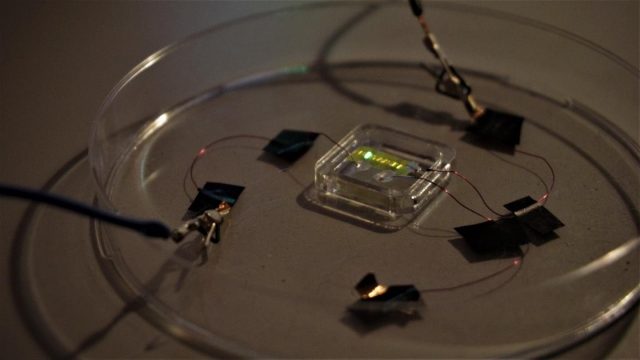Researchers at Duke University have revealed long-hidden molecular dynamics that provide desirable properties for solar energy and heat energy applications to an exciting class of materials called halide perovskites.
A key contributor to how these materials create and transport electricity...
Water is perhaps Earth's most critical natural resource. Given increasing demand and increasingly stretched water resources, scientists are pursuing more innovative ways to use and reuse existing water, as well as to design new materials to improve water purification...
Researchers at Utah State University are using silkworm silk to grow skeletal muscle cells, improving on traditional methods of cell culture and hopefully leading to better treatments for muscle atrophy.
When scientists are trying to understand disease and test treatments,...
Light microscopes have revolutionized our understanding of the microcosmos, but their resolution is limited to about 100 nanometers. To see how molecules bond, break, or change their structure, we need at least 1000 times better resolution.
Laser induced electron diffraction (LIED) is...
Using a nanopore, researchers have demonstrated the potential to reduce the time required for sequencing a glycosaminoglycan—a class of long chain-linked sugar molecules as important to our biology as DNA—from years to minutes.
As published this week in the Proceedings of...
The idea of creating selectively porous materials has captured the attention of chemists for decades. Now, new research from Northwestern University shows that fungi may have been doing exactly this for millions of years.
When Nathan Gianneschi's lab set out...
Researchers in the UK have developed a way to coax microscopic particles and droplets into precise patterns by harnessing the power of sound in air. The implications for printing, especially in the fields of medicine and electronics, are far-reaching.
The...
Texas A&M University researchers have recently shown superior performance of a new oxide dispersion strengthened (ODS) alloy they developed for use in both fission and fusion reactors.
Dr. Lin Shao, professor in the Department of Nuclear Engineering, worked alongside research...
Scientists at UCL and the IIT—Istituto Italiano di Tecnologia (Italian Institute of Technology) have created a temporary tattoo with light-emitting technology used in TV and smartphone screens, paving the way for a new type of 'smart tattoo' with a...
NUS scientists have devised a new method for the synthesis of nanographene molecules with a high product yield for the development of next generation quantum devices.
On-surface chemical reactions have shown potential in the synthesis of new organic functional materials such as...
As electronic devices saturate all corners of public and personal life, engineers are scrambling to find lightweight, mechanically stable, flexible, and easily manufactured materials that can shield humans from excessive electromagnetic radiation as well as prevent electronic devices from...


















